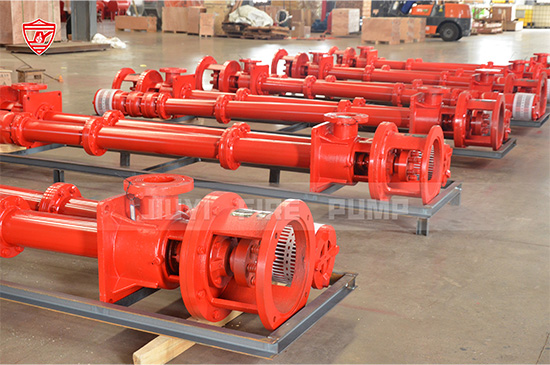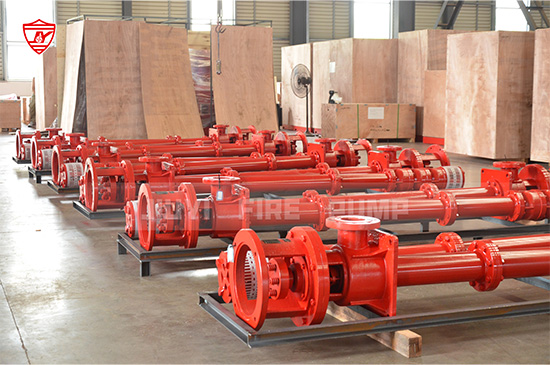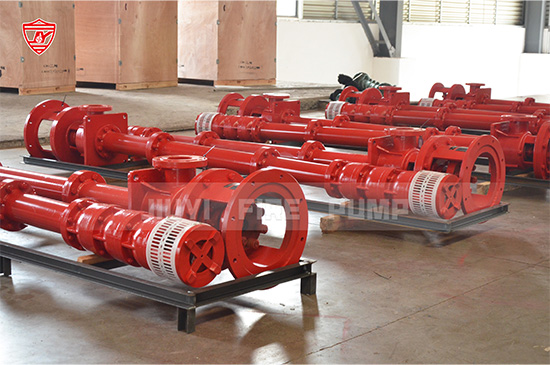In fire protection and industrial water systems, vertical turbine pumps are one of the most reliable solutions when a large volume of water needs to be moved from deep underground sources or open reservoirs. But have you ever wondered why it is called a “vertical turbine” pump? The name comes from the pump’s unique vertical design and the turbine-like impellers used to lift water efficiently from deep below the ground.
This article explains the origin of the name, the working principle, its advantages, and its importance in fire protection systems. If you are considering a vertical turbine fire pump for your project, understanding these fundamentals will help you make the right decision.

A vertical turbine pump (VTP) is a specialized centrifugal pump designed to lift water from sources where suction lift limitations prevent the use of horizontal pumps. Unlike standard end-suction or horizontal split-case pumps, VTPs are installed vertically and consist of multiple components assembled along a vertical column.
Vertical installation: The pump is positioned vertically, saving floor space.
Multi-stage impellers: Turbine-like impellers generate lift at different stages.
Column shaft design: A long shaft connects the impellers to the motor at ground level.
Deep-water capability: Capable of lifting water from depths exceeding 30 meters.
Because of these design features, VTPs are widely used for applications where water sources are below ground level, such as fire protection reservoirs, rivers, lakes, and wells.
The name vertical turbine pump is derived from two main design features:
Unlike horizontal centrifugal pumps, vertical turbine pumps are installed upright. This vertical positioning allows them to:
Reduce footprint and save floor space.
Draw water from deep underground sources.
Support applications in confined pump rooms.
The term “turbine” comes from the turbine-style impellers used in the pump bowl assembly. These impellers:
Rotate at high speeds.
Convert rotational energy into kinetic energy.
Efficiently lift large volumes of water upward through the pump column.
This combination of vertical configuration and turbine-like impellers gives the pump its descriptive name.

To understand why these pumps are so effective, let’s break down their working principle step by step:
Water enters the pump through a bell-shaped suction bowl at the bottom.
The first-stage impeller lifts the water and passes it to the next stage.
In multi-stage vertical turbine pumps, each impeller adds energy to the water.
The total head generated depends on the number of impellers.
A vertical column houses the pump shaft, which transmits energy from the motor to the impellers.
Bearings inside the column provide stability and smooth rotation.
At the top, a discharge head directs water into the piping system.
This section also houses the motor or drive system (electric motor or diesel engine).
This vertical arrangement allows the pump to deliver high flow rates from deep water sources with excellent efficiency.
Vertical turbine pumps are used in industries where high-capacity water supply is critical. Key sectors include:
Fire Protection Systems
Widely used in UL/FM-certified fire pump systems to meet NFPA 20 standards.
Municipal Water Supply
Ideal for pumping water from deep wells or open reservoirs to treatment facilities.
Industrial Water Systems
Used in power plants, manufacturing facilities, and refineries.
Agricultural Irrigation
Efficiently moves large volumes of water for irrigation from rivers or lakes.
In modern fire protection systems, vertical turbine fire pumps are essential, especially when the water source is below ground level or in an open reservoir.
Complies with NFPA 20 & UL/FM standards
Capable of high flow and high head for large facilities
Can operate with diesel engines for backup power
Long-lasting and highly reliable under emergency conditions
Many high-rise buildings, airports, warehouses, and industrial complexes rely on vertical turbine fire pumps to ensure a steady water supply during fire emergencies.
The turbine impellers provide better hydraulic efficiency than most horizontal pumps.
Since the pump is installed vertically, it requires less floor space, making it ideal for pump rooms with limited area.
VTPs can pump water from depths where standard centrifugal pumps fail.
Vertical turbine pumps are built for continuous, heavy-duty operation in demanding environments.
| Feature | Vertical Turbine Pump | Horizontal Split-Case Pump |
|---|---|---|
| Installation | Vertical | Horizontal |
| Water Source | Deep wells, reservoirs | Shallow tanks, pressurized systems |
| Space Required | Compact footprint | Requires more floor space |
| Efficiency | High for deep lift applications | High for shallow lifts |
| Fire Protection | Ideal for open reservoirs | Common in city-fed systems |
In situations where water sources are underground, vertical turbine pumps are the preferred choice.
To ensure optimal performance of vertical turbine fire pumps:
Regular Inspections: Check bearings, shaft alignment, and lubrication.
Performance Testing: Conduct flow tests per NFPA 25 recommendations.
Motor and Driver Checks: Inspect electric motors or diesel engines.
Impeller Cleaning: Remove debris to maintain efficiency.
Following a preventive maintenance program improves pump reliability and extends service life.
When selecting a vertical turbine fire pump, consider:
Required flow rate and head
Depth of the water source
Motor type (electric or diesel engine)
UL/FM certification and NFPA 20 compliance
Material selection for corrosion resistance
Choosing the right pump ensures system reliability and fire safety compliance.

Vertical turbine pumps are called so because of their vertical installation and turbine-style impellers, which allow them to lift water efficiently from deep sources. In fire protection systems, they play a critical role in ensuring a continuous water supply during emergencies, particularly when the water source is below ground level or in an open reservoir.
As a leading manufacturer of vertical turbine fire pumps, we provide UL-listed and NFPA-compliant solutions designed to meet the most demanding fire protection standards. By understanding how these pumps work and why they’re called “vertical turbine pumps,” you can make better decisions for your fire safety projects.